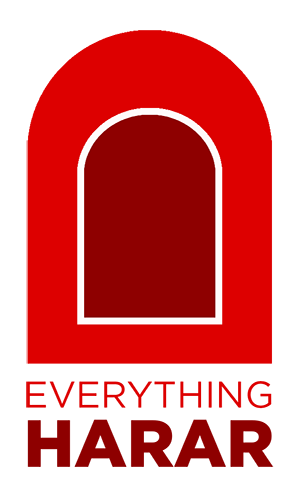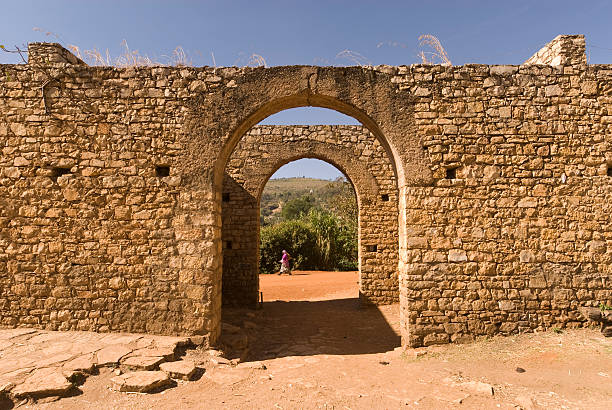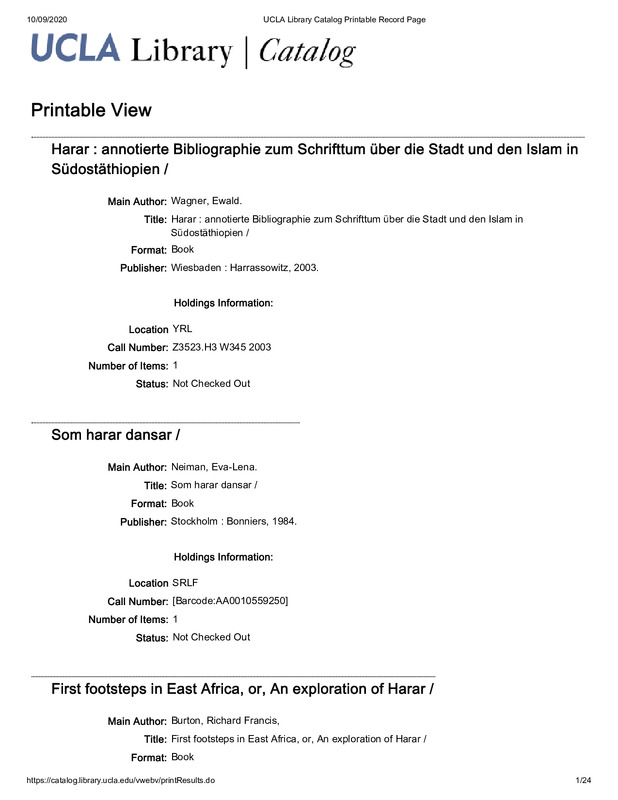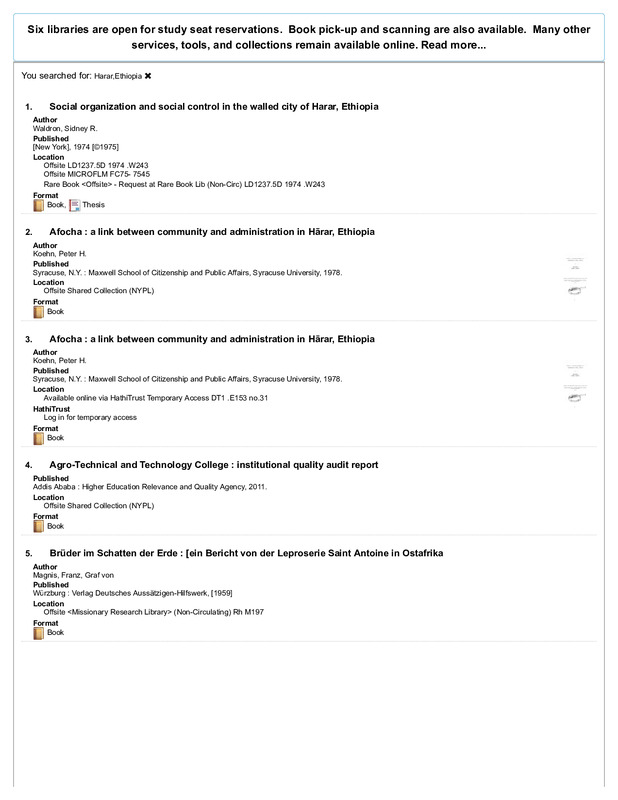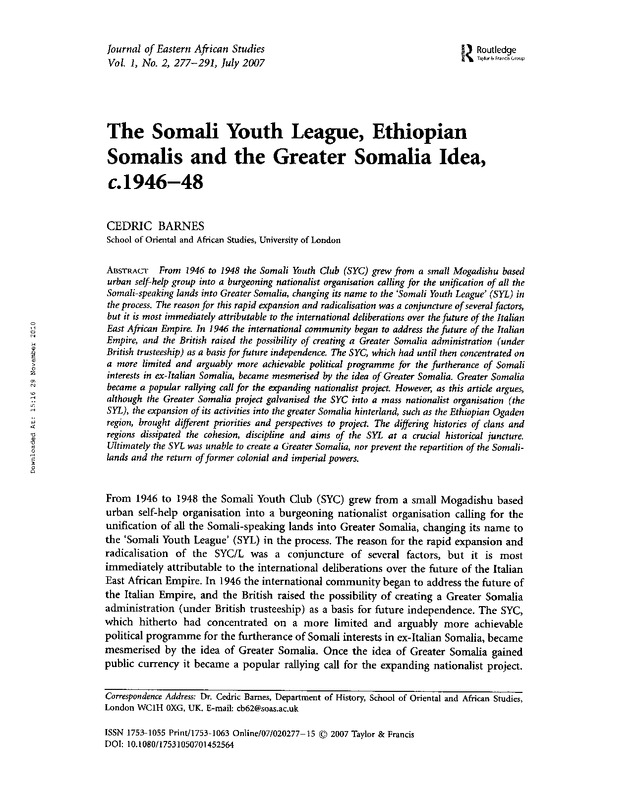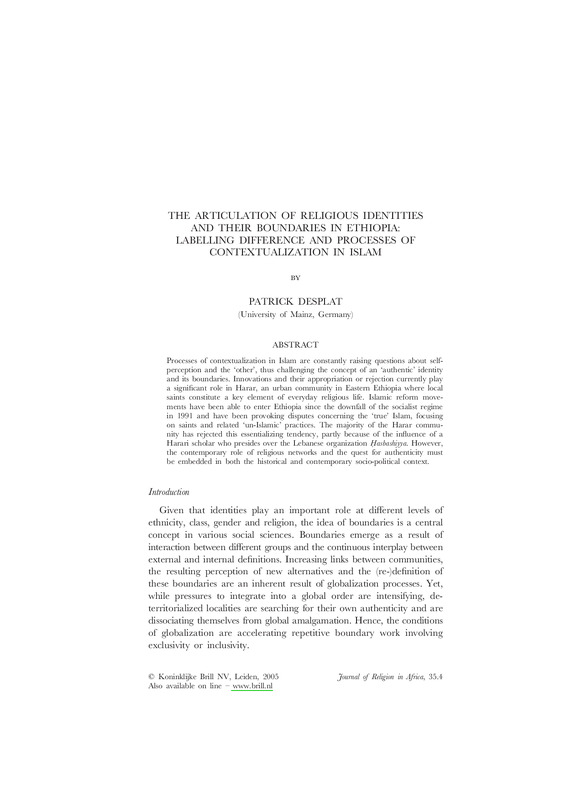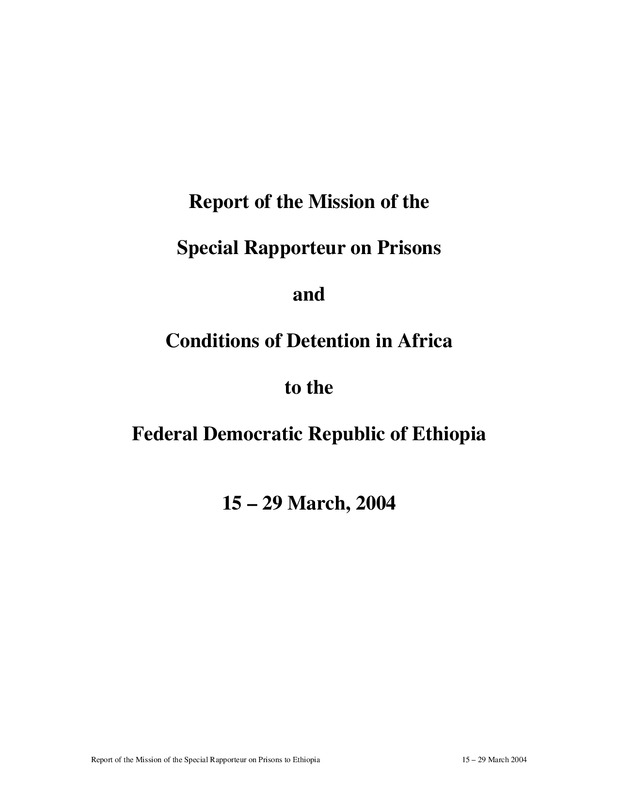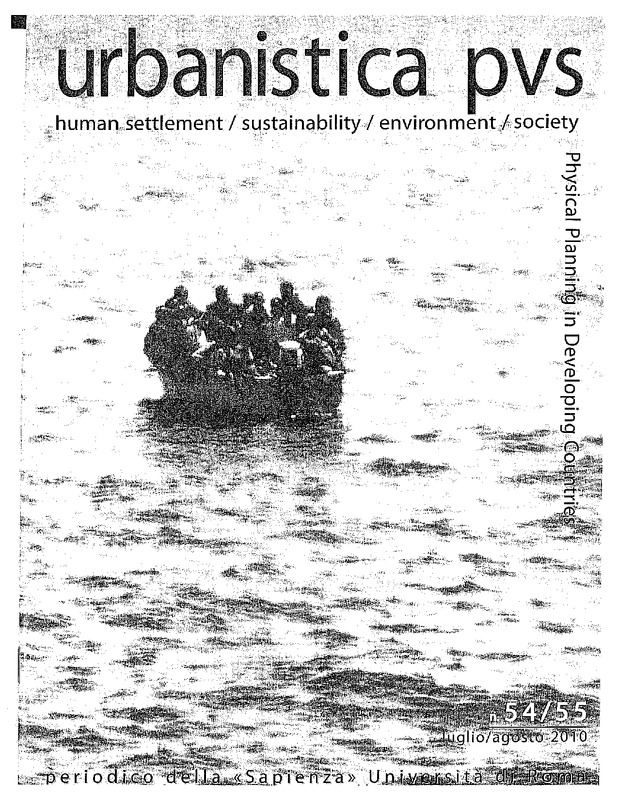Items
-
UCLA Library Catalogue (Harar)Date:[ 1 ] Dimensions of locality : Muslim saints, their place and space / Georg Stauth, Samuli Schielke (eds.) 2008 Location: YRL Call Number: BP189.43 .D56 2008 Status: In Process - 9 ] Azaïs, François, 1870- Cinq années de recherches archéologiques en Éthiopie; province du Harar et Éthiopie méridionale, par R. P. Azaïs et R. Chambard. Préf. par Edmond Pottier. 1931 [ 40 ] Waldron, Sidney R. Social organization and social control in the walled city of Harar, Ethiopia / Sidney Ralph Waldron. 1976
-
Columbia University On line Catalog (Harar)Date:-Harar. [electronic resource] Forschungsreise nach den Somâl und Gallaländern, Ost-Afrikas, ausgeführt von dr. Kammel von Hardegger und prof. dr. Paulitschke. Nebst beiträgen von dr. Günther ritter von Beck, L. Ganglbauer und dr. Heinrich Wichman Paulitschke, Philipp, 1854-1899. Leipzig, F.A. Brockhaus, 1888. Call Number: EBOOKS Available online -Harar : a cultural guide / text, David Vô Vân, Mohammed Jami Guleid ; in collaboration with, Berhanu Abebe. Vô Vân, David. Addis Ababa : Shama Books, c2007. Call Number: DT390.H3 V68 2007 Location: Butler Stacks (Enter at the Butler Circulation Desk) Harar y la rodilla rota : notas de lectura / Rafael Castillo Zapata. Castillo Zapata, Rafael, 1958- [Venezuela] : bid&co.editor, 2006. Call Number: 7JUN 1552
-
KhadijaDate: 1999Italian to English translation from Googlekhadija Paola PastacaldiPequod publisher, 250 pagesThe historical image of the novelThe story of "Khadija" was built on the historical sources of the late nineteenth century,as well as diaries and articles, including photos of the scouts.The following photos are a sort of imaginary path inthe novel and they see the city and the people of Harar(Archives of the Geographical Society of Rome and the Museum of Harar).Color photos are rather see Harar in recent times (of Paola Pastacaldi).The captions are taken from the novel.The two photos of Pavia explorer Luigi Robecchi Brichetti are taken from the book of John Zaffignani,"Luigi Robecchi briquettes Pavia traveler in Africa and in spite of a secret agent," Economic Pavia, 1990.The photo is taken from the Negus: Angelo del Boca, The Negus, life and death of the King of Kings, Laterza, 1995.The above description is translated using google translator. You can do the same for the rest of the document.
-
Old Harar CoinsDate:
-
Jewab Shahan EqadachleeDate:
-
Chat: Coffee’s rival from Harar, Ethiopia. II. Chemical compositionDate: 1973The early history, botany, cultivation, economics and sociological aspects of the use ofCatha edulis (Vahl) Forsk. ex Endl., commonly known as chat, have been presented in some detail. We have found general agreement in the literature as to the presence ofd-norpseudoephedrine in chat; the identity of the accompanying alkaloids is not at all certain. There is also disagreement as to whether or not the amounts ofd-norpseudoephedrine that have been determined occur in sufficient quantity to account for chat’s pharmacological action. Some investigators construe this as indicating the need for a holistic approach to the chemical pharmacology ofCatha edulis. Investigators claiming to have found additional alkaloids agree neither upon the number present nor upon their identities. It has been suggested that some of the anticipated additional alkaloids may well be congeners of others.
-
FROM THE SOMALI COAST THROUGH SOUTHERN ETHIOPIA TO THE SUDANDate: 1902In the spring of 1899 Baron Carlo von Erlanger asked me to join an expedition to Somaliland, which he intended to undertake for the sake of sport and ornithological research. I agreed on condition that the journey should not be confined to Somaliland, but should also extend to the countries of Southern Ethiopia. The preparations took nearly half a year. Meanwhile the revolt of the mad Mulla had broken out, and the western route proposed by myself proved to be the only one possible, as the Foreign Office was forced to recall its permission to penetrate the hinterland of Berbera, and we were therefore obliged to set out from Zeila by the old caravan route to Harar. The members of the expedition were Baron Carlo von Erlanger, Dr. Hans Ellenbeck as physician, Mr. Johann Holtermuller as cartographer, Mr. Carl Hilgert as taxidermist, and myself. We started from Zeila on January 12, 1900, but an accident to Mr. Carl Hilgert, who nearly killed himself with a small flaubert gun, stopped us at the wells of Dadab, only three marches from the coast, so that we did not arrive at Harar until the beginning of March. In the desert Baron Erlanger and myself preceded the caravan in order to meet Mr. Alfred Ilg, the foreign minister of the Emperor Menelik, who was on his way to the coast, and to whose valuable help a great part of the success of our expedition is due. But in the first place we have to thank the Emperor Menelik, that intelligent ruler and restorer of an ancient and great empire, for his help and permission to pass through his country.
-
A TRIP TO HARAR AND IME.Date:captain Swayne, who has been on a sporting expedition in Somaliland, writes from Aden:—I started from Bulhar on February 16th, 3,nd went to Jig-Jiga, where I found an Abyssinian guard of twenty -men posted in their stockaded fort over the wells. I had twenty-five Somalis, all told. Next day, an Abyssinian chief called Banaguse Ei Taurari marched into the stockade from Gqjai, about 20 miles to the west, accompanied by about three hundred and fifty horse and foot, to resist the supposed invader, the Somalis having exaggerated my trip into a British invasion. Nearly all the Abyssinians carried good Keniingtons. Banaguse seemed inclined at first to arrest me, but on hearing I had come up in order to visit Kas Makuwan, the Harar governor, he was afraid to do so. I sent a letter to Makuwan, and after I had waited at Jig-Jiga a few days, one Gakatagli came with a very polite note from the Eas, asking me to come to Harar. On nearing Harar I found I had to pass through two lines of soldiers, to the number of about a thousand, brought out to escort me, by order of the Kas, who is very hospitably inclined to the English. Each company presented arms as I passed along the path between the lines. I remained at Harar five days, a guest at the house of Alaka Gobau Desta; and before leaving I gave the Kas an Indian tiger-skin and an album of Indian photographs; receiving in return his photograph, a silver-mounted shield, spears, saddlery, and a good mule, also <a passport ordering any soldiers whom I might encounter in Ogaden to treat me courteously. I also received much kindness from Count Salimbeni and the Europeans at Harar.
-
Harari Xaba 1of 1Date: 1984 E.C.
-
Constraints and Opportunities of Horticulture Production and Marketing in Eastern EthiopiaDate: 39114"1. INTRODUCTION1.1 BACKGROUNDMore than 85% of the Ethiopian population, residing in the rural area, is engaged inagricultural production as a major means of livelihood. However, the agricultural productivityis low due to use of low level of improved agricultural technologies, risks associated withweather conditions, diseases and pests, etc. Moreover, due to the ever increasing populationpressure, the land holding per household is declining leading to low level of production tomeet the consumption requirement of the households. Hararghe highland is one of the highlypopulated areas in Ethiopia. As a result, intensive production is becoming a means ofpromoting agro-enterprise development in order to increase the land productivity. Horticultureproduction gives an opportunity for intensive production and increases smallholder farmers'participation in the market.The production of horticultural crops is a major element of the farming system of some of theworedas1 in the eastern part of Ethiopia such as Fedis, Haramaya, Kombolcha, Kersa, Meta,Kurfa Chelle, Grawa, Jarso in eastern Hararghe zone and some other woredas such asGemechis in western Hararghe zone, and Dire Dawa Provisional Administrative City Council.In the areas where irrigation water is available and farmers have access to the market,horticulture production is a major source of cash income for the households. Horticulturalproducts are supplied to the local markets and exported to Djibouti and Somalia. Horticultureproduction and marketing is one of the major sources of livelihood for a large number offarmers, transporters, middlemen and traders in the area."
-
HARRARDate: 2 April 1936HARRAR A MOSLEM CITY THE GARDEN OF ABYSSINIA (Written for "The Post" by W:S.R.) The bombing of Harrar, with ruthless slaughter of civilians, adds another to the many previous indictments of the Italian conduct of the Ethiopian campaign. Swedish, American, British, Egyptian, as well as Ethiopian Red Cross stations have all been the targets of the Italian aerial offensive, according to the indubitable testimony of scores of witnesses of the highest character. One would think -that if it were not possible for. civilised nations to invoke against the aggressor oil sanctions and stop these bloody massacres, there should in the name of common humanity be a mobilisation of shame against these persistent violations of every humanitarian instinct. But the only imperative of modern warfare seems to be victory at whatsoever cost, and by whatsoever means. The city of Harrar is beautifully situated ,on a hillside at an elevation of 5500 feet above the sea level. It enjoys an excellent climate, and is the centre of a fertile province. The landscape is said to be of surpassing beauty. Coffee plantations flourish throughout the province. These are here and there interspersed with forests of valuable timber of pine, cedar, and juniper. Its mountains rise to 9000 feet above sea level. Its beauty and fertility have earned for it the name of "The Garden of Abyssinia" The city was built several centuries ago by the Arabs. The population to-, day is about 60,000, most of whom own allegiance'to the Moslem, faith. The better class of buildings, . such as mosques, churches, consular dwellings, and the homes of Arab traders who control the commerce of the city, are of stone. The poorer houses are of rubble..The city is encircled by an ancient stone wall with twenty-four towers. The entry and exit are through five gates. At the outbreak of the war the wall was breached by the authorities in several places, to give the people readier exit in case of attack. Harrar is connected by a good motor road with Diredawa, a town mid-way between Jibuti and Addis Ababa on the railway. It is 200 odd miles distant from the capital. RAS MAKONNEN'S CONQUEST. The city and province, though once part of the kingdom now known as Ethiopia, for many centuries was under Moslem rule, and acknowledged the suzerainty of Egypt. When in 1884 the Egyptian Government was weakened through the Mahdi's conquest of the Sudan, the garrison of Egyptian soldiers was withdrawn from Harrar. This diminished the power of the ruler, the Emir Abdillah. When .in 1337 Ras MakonnSn, father of Haile. Selassie, invaded the province with 8000 Ethiopian warriors,, the 'city fell an easy prey to Ethiopian arms. The Emir was dethroned, and the province became part of the Ethiopian Empire. Has Makonnen, who was nephew-of Menelik, then King of Shoa, was appointed Governor. He was described as a cultured," humane, and enlightened ruler. It was in Harrar that his son Taffari, now the Emperor Haile Selassie, was born. He was educated at a French Roman Catholic Mission there, the buJdings of which are reported as having been destroyed by the recent aerial bombardment. On the death of Has Makonnen his son Taffari succeeded to the Governorship of the province, and it still continues under the Emperor's control. Haile Selassie owns also vast coffee plantations in the district, During the Great War Harrar became involved in a grandiose scheme of which Lij Nasa (Joseph) was the central figure. When Menelik II died in 1913, his nephew Lij Nasa, then a youth of seventeen, succeeded to the imperial throne. He is said even then to have been a dissolute craven. The Abouna was averse to crowning him Emperor, because of his evil habits, and also because of his flirtation with Islam. After the outbreak of the Great War emissaries were sent from Turkey and the Central Powers to stir up trouble in Ethiopia against the Allies; These gained the ear of Lij Nasa, and he became obsessed with the dream of a vast North-east African Moslem Empire to embrace Egypt, the Sudan, and all Somaliland, with headquarters in Abyssinia, and himself as Khalif, or supreme head. Lij abandoned the capital, Addis Ababa, for the more congenial company of . his Moslem subjects at Harrar. While at this centre he exchanged letters arid presents with Mohammed bin Abdulla Nassau (the Mad Mullah), who was leading a Jihad, or hoiy war, against British rule in Somaliland. On account of his Moslem proclivities, the Abouna, at the instance of Ethiopian nobles, dethroned Lij Nasa in 1916. It fell to Has Taffari Makonnen, then in his early twenties, to lead the campaign against the dethroned Emperor. The Emperor's forces were hopelessly defeated and he was taken prisoner. Summary vengeance was taken against the Harrar Moslems who were involved in the conspiracy. The aunt of Lij Nasa, Zauditu (Judith) was declared Empress, and Ras Taffari Makonnen, Regent. ! The Mullah hoped that the execution of the Harrar Moslems by Ras Taffari would Jead to a general rising of Moslems in Harrar, Ogaden, and throughout Somaliland against their "infidel" rulers. But Moslems in general felt that their slain co-religionists deserved their fate through being fooled by such a creature as Lij Nasa. In the present deplorable strife the Moslems of Harrar and throughout the Empire have shown no disposition to favour Mussolini against Haile Selassie, and, the wanton destruction of Harrar ' will deepen the mistrust of Italy, which is general throughout all Arab lands. 'I
-
Arthur Rimbaud, Coffee TraderDate: 2001When Arthur Rimbaud (1854-1891) abandoned poetry altogether in 1873, at the age of 19 or 20, he left behind a small, incendiary and revolutionary body of work that included "The Drunken Boat," A Season in Hell, and Illuminations, a series of mystical prose poems. He had come out of nowhere, from the small town of Charleville in the Ardennes. His parents were not literary. He began writing poetry at 13, serious poetry at 16. He came to Paris and befriended the poet Paul Verlaine. They had a tempestuous relationship which culminated in Verlaine's shooting Rimbaud in the wrist in a fit of hysteria. Verlaine went to prison; Rimbaud, after completing A Season in Hell, burned his papers and stopped writing altogether. All this in three short years. From that point onward, Rimbaud led an itinerant life marked by an insatiable restlessness and, especially in the end, a concerted and frustrated quest for money. His wanderings took him from one unlikely place to another: from Indonesia, where he deserted from the Dutch colonial army; to Scandinavia, where he interpreted for a touring Danish circus; to Cyprus, where he supervised road-building gangs; and, finally, in 1880, to Aden in the British protectorate of Yemen near the southern entrance of the Red Sea. Intermittently, he returned—or was repatriated, sick or penniless, by the French diplomatic corps—to his family in Charleville. It was a life from which literature was completely absent. As far as I can determine, in all the letters he wrote to his family during these last years, he never once mentions literature. (He does mention books, but they are invariably technical or instructional ones.) He certainly never wrote poetry again. He did write, though: He published several pieces on East Africa, including a treatise on Ogaden that appeared in the bulletin of the French Geographical Society. It was decently, though not memorably, written, but its author hardly seemed the same Arthur Rimbaud who had upset and forever altered the French literary world. In fact, like many before him and after, Rimbaud reinvented himself. The problem for posterity has been that with this reinvention, Rimbaud discarded his marvelous ability to spin words in the stars. When, some years later, Pierre Bardey's brother Alfred happened to learn that Rimbaud had written poetry and was revered in certain small circles in Paris, he confronted Rimbaud with this. Rimbaud seemed aghast: "Absurd! Ridiculous! Disgusting!" he said to Bardey. The Rimbaud who had written "The Drunken Boat" and A Season in Hell was dead and buried. The new Rimbaud wanted to make money. And, perhaps, to do some exploring and a bit of photography. This was the Arthur Rimbaud who arrived in Aden, Yemen in August of 1880: a different person entirely. At that time, coffee had become extremely popular in Europe, and especially in France. Though the plant was being cultivated elsewhere— notably in Java by the Dutch—the best coffee was considered to come from Yemen. Coffee had come into its own there. The name of the port of al-Mukha in Yemen had become synonymous with coffee, and still denotes a certain superior quality today. For years, Arab merchants and traders had kept coffee entirely to themselves. Releasing it at last to the outside world, they then held a monopoly on its trade. They knew a good thing when they saw one. Coffee's origin is placed variously in Yemen and Ethiopia, with most food historians now believing it to be the latter. Some believe that the word "coffee" derives from the name of the Ethiopian province of Kaffa. It was discovered perhaps as early as the ninth century, and the legend of its discovery was described by the French traveler Jean de La Roque in A Voyage to Arabia the Happy, published in English in 1726. La Roque writes that a goatherd noticed that after eating the berries of a particular bush his goats "leaped and frisked about all night." A local cleric heard of this and gave some of the berries to his disciples "to hinder them from sleeping, when they were called up to their prayers…." It was not a great leap from munching the berries to making a decoction of them, and from that to roasting the "beans" they contained before
-
Opening of the permanent exhibition of the Sherif Harar City MuseumDate: 2008Opening of the permanent exhibition of the Sherif Harar City Museum On 24 December 2008, the Sherif Harar City Museum, located within the walled Jugol of Harar, Ethiopia, celebrated the opening of its permanent exhibition. The Sherif Harar City Museum’s collection was founded by the museum’s current curator, Mr. Abdulah Ali Sherif, who has painstakingly acquired regional cultural objects since the early 1990s. A significant part of the collection was donated to the museum by members of the Harari community who entrusted the care of their heritage objects to Mr. Sherif. Permanent exhibitions of the Sherif Harar City Museum include items from the following regional groups: Harari, Oromo, Amhara, Gurage, Somali and Argobba groups. The collection includes everyday items such as textiles, jewelry, coins, basketry and weaponry. A rich archive of historically significant manuscripts and music recordings are also on display. The Sherif Harar City Museum received financial and technical assistance from the UNESCO/Norwegian Funds in Trust Cooperation project "Preservation of the Collection for the Cultural Heritage of the Harar City Museum". This included support for the renovation of the Ras Tafari House (which hosts the museum), the making of an inventory of the collection, purchase of equipment, exhibition design and training of museum staff. Title Opening of the permanent exhibition of the Sherif Harar City Museum Short Description On 24 December 2008, the Sherif Harar City Museum, located within the walled Jugol of Harar, Ethiopia, celebrated the opening of its permanent exhibition. The Sherif Harar City Museum’s collection was founded by the museum’s current curator, Mr. Abdulah Ali Sherif, who has painstakingly acquired regional cultural objects since the early 1990s. A significant part of the collection was donated to the museum by members of the Harari community who entrusted the care of their heritage objects to Mr. Sherif. Permanent exhibitions of the Sherif Harar City Museum include items from the following regional groups: Harari, Oromo, Amhara, Gurage, Somali and Argobba groups. The collection includes everyday items such as textiles, jewelry, coins, basketry and weaponry. A rich archive of historically significant manuscripts and music recordings are also on display. The Sherif Harar City Museum received financial and technical assistance from the UNESCO/Norwegian Funds in Trust Cooperation project "Preservation of the Collection for the Cultural Heritage of the Harar City Museum". This included support for the renovation of the Ras Tafari House (which hosts the museum), the making of an inventory of the collection, purchase of equipment, exhibition design and training of museum staff. Source UNESCO Nairobi Publication start date 2009-01-20 9:05 am Publication expiry date 2009-01-20 9:05 am Author(s) of the present sheet Fumiko Ohinata Organizer UNESCO Nairobi Event Location Ras Tafari House City Harar Country Ethiopia Start date - Local time 2009-01-20 9:05 am End date - Local time 2009-01-20 9:05 am Type of event (generic) Exhibition Display related links & contacts in right column No Name of Contact 1 Fumiko Ohinata, UNESCO Nairobi E-mail address
-
The Somali Youth League, Ethiopian Somalis and the Greater Somalia Idea, c.1946-48Date: 39264In 1946 Makhtal established the SYC in Harar with himself as President. It is noteworthy that such an anti-British figure should head an important branch of what had been a very pro-British nationalist organisation. Indeed it seems Makhtal's initial presence in Harar was to complain against the British Military Administration and its continuing disarmament campaign in the Ogaden.38 Harar was an important spiritual and political centre for the Ogaadeen Somalis, and it was logical that the Somali political club should have a branch there. When Makhtal first arrived in Harar he was well received by the Ethiopian government, which saw him as an important historical ally in the Ogaden against British and Italian colonialism. Furthermore, in 1946 the SYC still appeared to an ally of Ethiopia, and the Ethiopian government saw that it could even be used to support claims for a greater Ethiopia, including not only the Ogaden but also ex-Italian Somaliland, or at the very least to prevent the restoration of the Italians to their former colonies. British sources report that while he was in Harar the Ethiopian government paid him a healthy monthly allowance.39 However, once in Harar Makhtal's politics began to change. Harar had been under full Ethiopian control since 1942 and like many areas of Muslim Ethiopia the local population did not wholly welcome restored Ethiopian government. Harari townsmen had been given a certain amount of privilege and promotion during the Italian occupation, resulting in a social and economic revival directly linked with the demotion of 'Amhara Christian' political dominance. But three years after the restoration of Harar to Ethiopia, Harari townsmen once again found themselves under the dominance of Ethiopian Christian outsiders, and had lost what social and economic gains they had made under the Italian regime. As a result of these grievances an ethnic Harari association was founded sometime in 1945 or 1946, which is remembered today with two Arabic titles, the jam'iya al-wataniya or jam'iya hurriya al harariya, translated respectively as 'the nationalist society' or 'the society for Harari freedom'.40 However when Makhtal Daahir established the SYC in Harar, the smaller Harari society allied itself and merged with the club, presumably to achieve more political influence. After exposure to the restored Ethiopian government in Harar and the local resentment it had engendered, Makhtal began to see the Ethiopian government as just as detrimental to Ogaadeen and Somali aspirations as he considered the British to be. British sources record that Makhtal's nationalism was further spurred by being kept waiting in Addis Ababa for an audience with the Emperor where he met several Eritrean Muslims who influenced his attitude to the restoration of Ethiopian rule.41 By early September 1947 Makhtal left Harar and returned to the safety of Ogaden, still under British Military Administration where the Ethiopian police had no jurisdiction. However, BMA jurisdiction did not deter the Ethiopian government from flexing its muscles in Jigjiga in the RA where Ethiopian police attempted to arrest the vice-President of the Harar branch of the SYL, Haji Kalile Ahmed, but where large numbers of SYL members prevented him being taken to Harar.45 In another symbolic act signalling the Ethiopian sovereignty of the Ogaden, the Ethiopian government granted a concession to the American Sinclair Oil Company to prospect for oil in the Ogaden still under the BMA.46 This was a clear sign that the Ethiopian government would now push for the return of the RA and Ogaden. Furthermore, in the face of an increasingly belligerent SYL and in anticipation of regaining control of the RA, the Ethiopians appointed a more vigorous Ethiopian representative in Jigjiga whom the British officials described as 'a senior official of strong anti-British persuasion to check the growth of the SYL in Jigjiga'.47 The Ethiopian government, not without foundation, strongly suspected that the British were fostering the growth of the SYL.48
-
Italian Bombs Destroy HararDate: 1936Harar, the second largest city in Abyssinia, was practically destroyed to-day, when 37 Italian bombers engaged in a mass air raid on the city.
-
THE ARTICULATION OF RELIGIOUS IDENTITIESDate: 2009Religious difference in Islam: case studies from Harar Harar is a town in the eastern region of Ethiopia. It is located near the border of what is now Somaliland and has approximately 100,000 inhabitants who belong to different ethnic groups, mainly Hararis, Oromo, Amhara and Somalis. In this section I concentrate mainly on the Harari people who are the descendents of local groups and Arab immigrants and thus claim to be the founders of the city. Despite being a minority—they represent only seven percent of the town’s population— they enjoy an elevated status among their ethnic neighbours based on their economic power as traders and their religious knowledge. Since the reorganization of administrative structures by the state since 1991, Harar has become the smallest administrative unit in Ethiopia. This development guarantees special legal rights for the Hararis and underlines the importance of their current political role. Despite the fact that Harar has relinquished its status as the most influential Islamic centre in the Horn of Africa, it has retained its symbolic capital. This is reflected in local terms such as madìnat al-awliyàh, the city of saints, and its label as the fourth holiest city in Islam. While the latter undoubtedly involves the reinvention of a weak local tradition by today’s tourism sector, the former term is actually legitimate as the town contains hundreds of saintly places inside its old walls and many Islamic shrines in the countryside beyond. Historically, the town attracted many religious scholars and students and thus became a centre of religious learning. It was also an important trade centre linking the Red Sea with the interior of Ethiopia, and this role lends it its special importance. Harar was established in the thirteenth century and later emerged as the capital of the Sultanate of Adal. In the sixteenth century, Imàm A˙med Ibràhìm, a Muslim scholar from the region of Harar, nicknamed ‘Grañ’, the left-handed, succeeded in uniting different quarrelling 488 Patrick Desplat The Articulation of Religious Identities and their Boundaries in Ethiopia 489 factions of Muslims and conquered extensive parts of Ethiopia during a djihàd (1529-1543) against the Christians. With the defeat of Imam A˙med (1543) and the later migration of the Oromo, Harar became a city-state governed by an emirate. It was captured in 1875 by Egypt and in 1887 the then emperor Menelik II incorporated Harar into the wider empire of Ethiopia, imposing a Christian rule for the first time.
-
The Extended East RouteDate: 2009The Extended East Route An International Symposium on the new cultural, naturalistic tourism route in the Ethiopian East concludedWe Have started work on a new Tourism Route. The long expected alternative to the Great Ethiopian North, designed in.. 1966. A concrete possibility of income for many thousands, of fresh needed foreign earnings for Our Land.This section covers over 40 pages, list of contents:- Harar Symposium programme- Ten points to realize the new Route- What is the Extended East Route?- First notes on the Somaliland leg of the Route- Birdwatching, preliminary scientific enquiries, partecipation to a significant ornitological congress. Proposal to realize a Bird Guide to the Ethiopian East.- Why the Kundudo is a focal point of the East Tourism Route- The two most recent discoveries on the Kundudo range- Notes on the first steps undertaken, about a visit to the Oromia State President- A visit to the Kundudo, in... 1853The Harar SymposiumWhat we did: September 25, early morning. Departure from Addis Ababa. Lunch in Nazaret, brief visits along the way, like at the Giulietti pass Caldera, lake Beseka, along the Amhar mountain chain. Night in Harar. Guests of the local Cultural and Tourism Office, for some experts, at the Home of Dr. Nasib, an Harari personality.
-
A fantastic Karst cave fieldDate: 2008/9A fantastic Karst cave field THIS SITE SECTION CONTAINS TEN NOTES ON EXPLORATIONS I RECENTLY LED. If you reached us via a search engine, please scroll to the section of your interest.About a year ago, after the rediscovery of a feral horse pack on the flat top of Mount Kundudo, I tried understanding its geology by visiting its lower parts too. The top is a stunning humid area, with grasses and a few remnant shrubs, it hosts a variety of wildlife including many couples of Lammergeier, the rare bird of prey, mustelids and baboons. Rocks up there are all very acidic, splitting black basalts, that form a cave just under the top. From the cave flows the Immis stream, that immediately forms a spectacular 250m waterfalls with four jumps. Just under, the rocks turn suddendly from black to white. It is clear the 400m of basalts had protected the underlying mass of limes, letting the Kundudo stand prominently at nearly 3000m, dominating the whole area and giving us views over Harar and as far as Hargeisa in Somalia. Springs and streams flow from all around its base, giving the Gursum province a fame for the production of all sort of horticultural goods, lately, of chat for export
-
ARABIC LITERATURE OF AFRICA:Date: 2005Moving eastward to consider Eritrea, Ethiopia and Somalia, our information is very patchy and uneven. However, one contrast with other areas of Muslim Africa is that northeastern Africa has received the attention of a number of distinguished Orientalists. Thus Enrico Cerulli has written with great authority on the Arabic writings of Somalia while Ewald Wagner has comprehensively catalogued, described and analysed the indigenous writings, in Arabic, Harari, and Silte, of the city state of Harar.9 More recently researchers such as Hussein Ahmed (Addis Ababa), Scott Reese (Northern Arizona University ), Alessandro Gori (Naples) and Jonathan Miran (Michigan State University) have been 8 ˘asan b. Mu˛ammad al-Fti˛ b. Qarıb Allåh; see ALA I, 113. 9 See Afrikanischen Handschriften, II, Islamiche Handscriften aus Äthiopien, Stuttgart, 1997. 14 actively engaged in mapping and cataloguing in the region. What is known to date of the Islamic writings of northeastern Africa is brought together in ALA IIIA, entitled The Writings of the Muslim Peoples of Northeastern Africa, published by Brill, early in 2003.
-
Assessment ReportDate: 1994The DSA Project is providing technical assistance to the Government of Ethiopia’s Civil Service Reform in the areas of budget, accounts and expenditure planning. The DSA Project is implemented by Harvard University and funded by USAID, Ireland Aid and the Netherlands Ministry for Development Corporation. Project at the Federal Government and in the Tigray, SNNP, Oromia, Amhara and Beneshangul/Gumuz regions. The Accounts Reform has so far been implemented with the support of the DSA Project at the Federal Government and in the Tigray, SNNP and Amhara regions. The DSA Project was extended from July 1 2004 to November 30,2006 to ensure that the above reforms are extended to all regions and administrative areas of Ethiopia. A part of the work plan agreed with the Ministry of Finance and Economic Development envisages that the budget and the accounts reforms are introduced in Hararri Region in FY 1998-99. To achieve this goal, the reform activities should commence in FY 1997-98. The DSA Project conducted an assessment of the Region in September 2004 with the following objectives: • To obtain a full understanding of the Region in areas such as restructuring, status of the budget reform, status of accounts closure, and its impact on the Budget and Accounts Reform. • To identify whether adequate technical staff capacity exists to effectively implement the reforms. • To identify other constraints that may negatively impact the introduction of Accounts Reform in the Region. • To develop a joint action plan and strategy to strengthen the Budget Reform and implement the Accounts Reform.
-
Special Rapporteur On Prisons...Date: 2004At the 33rd Ordinary Session of the African Commission on Human and Peoples’ Rights (ACHPR) held in Niamey, Niger, the Special Rapporteur on Prisons and Conditions of Detention in Africa, (SRP) Commissioner Dr. Vera Chirwa held discussions with the government delegates from the Federal Democratic Republic of Ethiopia (FDRE) to explore the possibility of a visit to the country. At the 34th Ordinary Session of the African Commission held in Banjul, The Gambia, the FDRE made an open invitation to the Special Rapporteur to visit Ethiopia at any time. In consultation with the government of Ethiopia, a mission was scheduled for 15 – 29 March 2004. The mission falls within the mandate of the Special Rapporteur to monitor prisons and other places of detention in Member States of the African Union and make appropriate recommendations on how to enhance the rights of persons deprived of their liberty. 5. Harari Region The Harari Region is the smallest of the 11 regions in Ethiopia with a population of only 175.900 inhabitants and a land area of 374 Km². The capital of the region, Harar is one of the most popular historical towns in the Eastern part of Ethiopia. The State has no administrative zones or Woredas. It has about 19 Kebeles. The Region has located in the Eastern part of Ethiopia, surrounded by the Oromia Region. The ethnic composition includes Oromo 52.3%, Amhara 32.6%, Harari 7.1%, and Guragies 3.2%. Harari language is the official language of the State. The religious composition of the population indicates that 60.3% are Muslims, 38.2% Orthodox Christian, 0.9% Protestants, 0.55 Catholics, and 0.1% followers of other religious groups. The region has only one prison with an inmate capacity of 1000 but holds about 1370 prisoners – 1296 male and 74 female. It must be noted here that more than half of the inmates in this prison are from the Oromia Region detained in the Harar prison because the Oromia regional government does not have enough prisons to keep them in. While in the Harar prison, the Oromia regional government provides money for their daily upkeep and transportation to court for those whose cases have not been disposed. The prison has a small clinic with no resident doctor but has three nurses – 2 assistant nurses and a sanitation officer. The male section is separated from the female section. A juvenile cell of 4m x 7m with 12 inmates is not completely separated from the adult section as there is free movement of adults in and out of the juvenile block. The prison had 31 cells of different sizes – some 4m x 5m with 10 inmates, some 6m x 7m for 29 inmates, some 5m x 7m for 14 inmates and others 6m x 15m for 55 inmates. The 84 female prisoners are living in only 4 cells some of them with very rough and dirty walls. The walls, as well as the floors are not cemented. The area is very small and has no space for recreational and other activities. The prison has a volleyball court and offers vocational training – woodwork, metal work, and brick laying only to male inmates. The authorities plan to introduce sewing for female inmates. There is a school that offers classes up to grade 6. The school is accredited by the regional ministry of national education. There is an acute shortage of water in the prison. This is as a result of water shortage in the region as a whole.
-
Harar, Ethiopia. Dualities, discursive meanings and designationsDate: 2010Published in English with Italian summary in Urbanistica pvs (La Sapienza, Univ of Rome), 54/55: 28-37, 2010Harar is a city of 120,000 inhabitants situated on a plateau in an agricultural region of eastern Ethiopia. The city is divided into new and old districts and is separated - spatially and symbolically - by high walls punctuated by six gates through which foot and vehicular traffic pass. Oral tradition has it that the old city, Harar Jugol, dates to the 10th century, whiles the new city, named New Town in this article, dates to the latter 19th century. Perhaps related to this newness, scant attention has been accorded to New Town’s built form in contrast to Jugol, the city located within the fortifications. In this article divided into three parts, a critical ethnographic lens is employed to problematize characteristics of Harar’s spatial and social terrain. Low’s (1996) theoretical framework for contemplating and analyzing cities is used to explore numerous dualities, boundaries and tensions that exist in Harar’s current urban environment, with focus placed upon New Town. This paper conceptualizes Harar as a discursive realm, where signs and symbols written on the city’s landscape and in the daily practices of citizens point to linkages to broader social processes, politics, policy, and ideology. The analysis concludes by critically exploring three challenges that currently face the city of Harar with respect to urban planning and land use that are challenging to reconcile because of dissimilar understandings of the city, competing roles in urban governance, and the unavailability of a sufficient local water source.
-
Battle of CheleqoDate:The Battle of Chelenqo was an engagement fought on 6 January 1887 between the army of Shewa under Negus Menelik II and Emir 'Abd Allah II of Harar. The Harari forces were routed, and Negus Menelik afterwards occupied and annexed the city of Harar. Negus Menelik, in response to Italian control of parts of Eritrea and the port of Massawa, had begun to import firearms and munitions through the French-controlled ports of Djibouti. By 1886, Emir 'Abd Allah of Harar had blocked transport of these arms through his territories. Menelik had desired control of the city of Harar for some time. The massacre of the Italian explorer Count Pietro Porro and his entire party in April 1886, allegedly at the emir's command, gave the Negus an excuse to march on Harar.[1] Although the army of Shewa was a veteran force with contemporary rifles, and numbered in the thousands, Negus Menelik sought to avoid war, and in January 1887, offered 'Abd Allah the same kind of autonomy that king Abba Jifar of Jimma enjoyed; the emir refused this offer. Knowing that he was heavily outnumbered, and his troops had only obsolete matchlocks and a few cannons, Emir 'Abd Allah decided to attack on early in the morning of Ethiopian Christmas (January 9), expecting the Shewans to be unprepared and befuddled with food and alcohol. However, Negus Menelik had worried about a surprise attack, and kept his men at alert. The emir's men opened fire at 11:00 am. The Shewan soldiers quickly responded and routed the Harar infantry with few casualties. Menelik pursued the retreating emir to Harar, whose ancient walls would not long resist his assault. Once again 'Abd Allah refused to surrender, then fled into the desert, leaving his uncle to negotiate the city's surrender. With the occupation, the independence of Harar came to an end.
-
Harar Water Supply & Sanitation ProjectDate: 2002DescriptionThe project will consist of the following components: 1. The project consists of the following main components: 2Water Production: This will consist of the following outputs: Four additional boreholes in the Dire Jara wellfield, a 75 km long, 600 mm diameter ductile iron transmission pipeline, and introduction of an aquifer monitoring system. The Dire Jara wellfield consists of 12 new boreholes which have already been developed with a capacity of 200 l/s. The additional boreholes with a capacity of 68 l/s will be constructed at the wellfield increasing production capacity to 268 l/s. All the boreholes will be connected to a 2000 m3 Collector Reservoir from which the transmission pipeline will transfer the water to Harar and the other towns raising it about 840 m via 4 booster pumping stations to a 4000 m3 reservoir at the highest point in Dengego. Pump houses, staff houses and administrative buildings and access roads will also be constructed at the wellfield and the booster stations. A pipeline from the wellfield to Dire Jara will serve the villagers with one of the boreholes. Equipment and chemicals for groundwater monitoring will also be provided. 3Water Distribution: The main outputs of the component are the rehabilitation and extension of 115 km of distribution network with a number of service reservoirs and break pressure tanks, 47 public fountains, and provision of 4000 consumer meters and a meter test bench. The activities include the replacement of the distribution network in Jegol, and its extension to other parts of Harar, Alemaya and Awudai. Service reservoirs or break pressure tanks will be provided in each distribution zone. In addition 47 community managed public fountains will be constructed for low-income consumers and 4000 consumer meters provided for new house connections. A meter test bench and meter repair kits as well as plant and equipment and spare parts for operation and maintenance will be provided. 4Sanitation: This component will have the following outputs: 3 public latrines and 35 community managed communal latrines, 2 large and 1 small vacuum tanker, 2 refuse collection vehicles, and 35 refuse bins (transfer containers), 12.2 km of drainage system, and sanitation study report. The 3 public latrines and 35 community managed communal latrines will be constructed in different parts of Harar, Alemaya, Awudai, Adele and Dengego in locations identified by the communities. A drainage system consisting of 2.2 km of open channels and 10 km of closed conduits will be constructed in Harar. The 2 large and 1 small vacuum tanker will be provided for emptying septic tanks and soakaways and pit latrines in the towns. The small tanker will serve the narrow streets of Jegol while the large tankers will serve the rest of the towns. In addition, a sullage system is being implemented in Jegol with funding from the ESRDF, which will serve to evacuate the increased quantities of water flowing into Harar. The 35 refuse transfer containers and 2 refuse collection vehicles will serve to improve the solid waste management system. 5The project will also fund a sanitation study which will determine the feasibility of converting the sullage system into a small-bore shallow sewerage system for Jegol and the rest of Harar as well as address the sanitation problems for the medium and long-term. The study will also determine feasible options for an improved solid waste management system, which will include the development of a proper dumpsite as well as look into the feasibility of community waste recycling as a means of livelihood. 6Public Education: The outputs of the component are increased awareness of water and health relations, HIV/AIDS and acceptance of the tariff increases. The activities include the use of the media, seminars, workshops, development and wide dissemination of publicity materials, etc, to raise awareness about water quality and health, water related diseases, HIV AIDS, and the need to raise tariffs in the town to meet the high cost of the proposed water supply system. It will be conducted by the Information and Health Bureaus of the Harari Regional Government. 7Institutional Support to HTWSSSA: The outputs are a better managed utility operating on commercial lines, with improved customer database, regular monthly billing, improved revenue collection to 90% of billing, and reduction of unaccounted for water to 18%. HTWSSSA will be provided with technical assistance in the areas of utility management, operation and maintenance, commercial and financial management. The civil works contractor and supervision consultant will provide the required operation and maintenance manuals and training in their use and operation and maintenance management in general. In addition experts will be recruited from a firm of water utility operators to assist HTWSSSA to put in place the proposed institutional structure, recruitment of the required additional staff, development of manuals for and training of the staff in various aspects of utility management, commercial and financial management and in the use of appropriate computer software and hardware. --------------------------------------------------------------------------------ObjectivesTo improve access to water supply and sanitation services in Harar, Alemaya, Awudai, Adele and Dengego through improved water production, distribution and sanitation for improved health, poverty alleviation and economic growth. --------------------------------------------------------------------------------BenefitsThe project will restore water supply to meet domestic and industrial demand in Harar, Alemaya and Awudai to the year 2024 and improve the sanitation situation in the towns. This will reduce the incidence of water related diseases and the proportion of the health budget and family income used to treat such diseases as well as the time lost due to illness from such diseases. The time spent by women and children collecting water will reduce as well as school absenteism by girls. The project will make it possible for a number of industries to be established in Harar, which are presently prevented from doing so by the lack of water. This will create jobs and improve the economic situation in the area. --------------------------------------------------------------------------------Key contactsALEOBUA Boniface Osimua Yakubu - OWAS2 --------------------------------------------------------------------------------CostsFinance source Amount ADF UAC 21,010,000 Co-financier UAC 6,100,000 Delta UAC 1,880,000 Total UAC 28,990,000 SubscribeRSS feedsEmail alertsKey documentsNEPADProject Appraisal ReportsProject/Programme Completion ReportsLoan and Grant ConditionsProjects Performance Evaluation ReportCompletion Reports ReviewProjects EvaluationLending RatesRisk ManagementProcurement NoticesIntegrity & Anti-Corruption ReportsEnvironmental & Social AssessmentsUseful LinksIndependent Review MechanismIntegrity and Anti-Corruption
-
Harari ChildrenDate: 2002The publiction looks into the Harari Identity based on discussions made among Hararis on the Harari Net.
